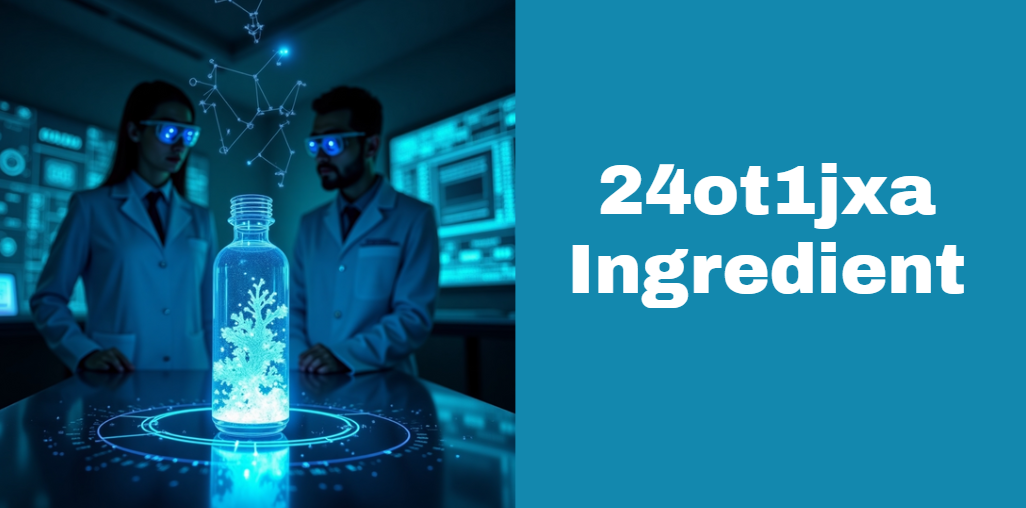What is the 24ot1jxa Ingredient? Uncovering the Digital Code and Chemical Controversy
The 24ot1jxa ingredient is not a recognized substance in traditional food or cosmetic labeling databases, nor is it an FDA-approved additive name. Rather, it appears to be an identifier—possibly a product code, digital token, or an obscure chemical reference.
There are two primary contexts in which this term is being circulated:
- As a digital identifier, used internally in databases, software systems, or URLs.
- As a potential placeholder or obscure name in the ingredients list of industrial or commercial goods—perhaps tied to less regulated or experimental substances.
Due to its ambiguity, exploring both interpretations helps consumers and professionals alike understand the implications behind such cryptic labeling.
Digital Identifier Context
Structure & Characteristics
In software engineering and database management, codes like 24ot1jxa are commonly used as unique identifiers. These can be randomly generated alphanumeric strings that help systems distinguish between different sessions, records, or API calls.
Such identifiers often:
- Are case-sensitive
- Range from 8 to 32 characters
- Contain a mix of letters and numbers
- Have no direct human-readable meaning
Common Use Cases
The term “24ot1jxa ingredient” may have originated from a misplaced or misunderstood identifier found in a tech-related database or online product registry. Below are a few areas where such identifiers are used:
| Use Case | Purpose |
|---|---|
| Session Tokens | Manage user authentication |
| API Keys | Authorize communication between apps |
| SKU/Product IDs | Track inventory or digital goods |
| URL Slugs or Redirects | Simplify page referencing |
| Database Document IDs | Index records uniquely |
Importance in Tech Infrastructure
Identifiers like 24ot1jxa ensure that machines, databases, and web systems remain organized, secure, and efficient. For example, a user’s interaction on a website might be stored under an ID like “24ot1jxa” to track their preferences, behavior, or cart status.
However, problems can arise when these IDs leak into public-facing platforms or are accidentally labeled as product “ingredients,” causing confusion.
Chemical or Ingredient Context
Although there’s no official listing for “24ot1jxa ingredient” in reputable chemical databases such as PubChem or the EPA’s Substance Registry, some speculate that it may refer to a synthetic compound or a placeholder name in chemical formulations.
Such ingredients often appear in:
- Industrial cleaning agents
- Specialized coatings or sprays
- Experimental skincare formulations
- Food packaging or adhesives
It’s possible that “24ot1jxa” was:
- A test batch code temporarily listed in a formula
- A proprietary ingredient name masked for trade secrecy
- A digitized reference mistakenly placed on a label
Typical Uses & Concentrations
If used as a chemical, the “24ot1jxa ingredient” might be found in trace concentrations, typically ranging from 0.01% to 1.5%, depending on its function (e.g., preservative, solvent, stabilizer). Such concentrations can be difficult for consumers to detect or interpret without access to full Safety Data Sheets (SDS).
Health and Environmental Impact
Assuming the 24ot1jxa ingredient refers to a synthetic compound, there are key risks associated with such substances, especially if they’re derived from unregulated classes like PFAS (per- and polyfluoroalkyl substances) or volatile organic compounds (VOCs).
Human Health Risks
Potential health issues may include:
- Skin irritation or allergic reaction (in cosmetics or personal care)
- Endocrine disruption (for hormone-mimicking chemicals)
- Liver and kidney toxicity (from long-term exposure)
- Developmental delays in infants and children (via exposure during pregnancy)
Environmental Concerns
Substances similar to the possible nature of “24ot1jxa” often:
- Do not degrade easily in nature
- Accumulate in soil and water
- Contaminate food chains via runoff or bioaccumulation
In short, synthetic chemical ingredients, especially unnamed ones, can be both harmful to people and damaging to ecosystems over time.
Regulation & Safety
Industry Oversight
Global agencies have started regulating mysterious ingredients and coded compounds. Here’s how the regulation typically breaks down:
| Region | Agency | Focus Area |
|---|---|---|
| USA | FDA, EPA | Cosmetics, foods, environment |
| EU | ECHA, REACH | Chemicals in consumer goods |
| Global | ISO, WHO | Standards & toxicity reviews |
If 24ot1jxa is found to be a hazardous chemical or ingredient, it may fall under scrutiny from these entities.
Trends in Transparency
Consumer demand is leading manufacturers to remove unknown or under-researched ingredients. Labels now frequently include:
- “Free from PFAS”
- “No unlisted chemicals”
- “Full disclosure of all additives”
This trend is encouraging for uncovering what cryptic terms like 24ot1jxa ingredient might actually be.
How to Identify 24ot1jxa Ingredient in Products
On Labels and Packaging
If you come across a term like 24ot1jxa ingredient on a product label:
- Check for an accompanying Chemical Abstract Service (CAS) number.
- Visit the brand’s website or scan any QR codes that may direct you to the full ingredient list.
- Look at consumer forums or safety reporting databases like EWG’s Skin Deep.
Scientific Analysis
To verify such an ingredient scientifically, laboratories use:
- Gas Chromatography–Mass Spectrometry (GC-MS)
- Fourier Transform Infrared Spectroscopy (FTIR)
- High-Performance Liquid Chromatography (HPLC)
These tests reveal exact molecular compositions and help determine the safety of obscure ingredients.
Reducing Your Exposure
If you’re unsure about any product listing the 24ot1jxa ingredient, consider these safety tips:
- Switch to known brands with transparent ingredient disclosures.
- Avoid “fragrance” or “proprietary blend” labels, which may hide synthetic chemicals.
- Use third-party certified products such as USDA Organic or EWG Verified.
- Filter your water using reverse osmosis to avoid chemical residues.
- Choose PFAS-free cookware and packaging, especially for food and drink.
Alternatives and Future Outlook
With rising concerns about synthetic, unnamed ingredients, industries are shifting toward safer, greener alternatives. Emerging alternatives include:
- Bio-based surfactants
- Plant-derived preservatives
- Eco-labeling systems and databases (e.g., INCI, COSMOS)
Consumers are now more informed than ever and are pushing companies to drop confusing or coded ingredients like “24ot1jxa” from product listings entirely.
Conclusion
The mystery surrounding the 24ot1jxa ingredient serves as a reminder of how complex and sometimes misleading product labeling can be. Whether this term is a digital code mistakenly treated as a chemical or an unlisted additive hidden in plain sight, it underscores the need for vigilance, education, and transparency in consumer goods.
Understanding what we use—and what we’re exposed to—starts with asking questions. The next time you see an unfamiliar term like “24ot1jxa,” dig deeper, demand clarity, and always prioritize safety.
Recommended Articles
What is 1-888-541-8306? Full Guide to Toll-Free Customer Support & Safe Usage
Wizards Black Jerseys Mahmood NBA 2K: A Deep Dive into Culture, Style and Gaming
Kwal Paint 961-240: The Ultimate Guide to a Superior Paint Finish
RT69264 10-Hook Rack: The Ultimate Space-Saving Organizer for Every Room






